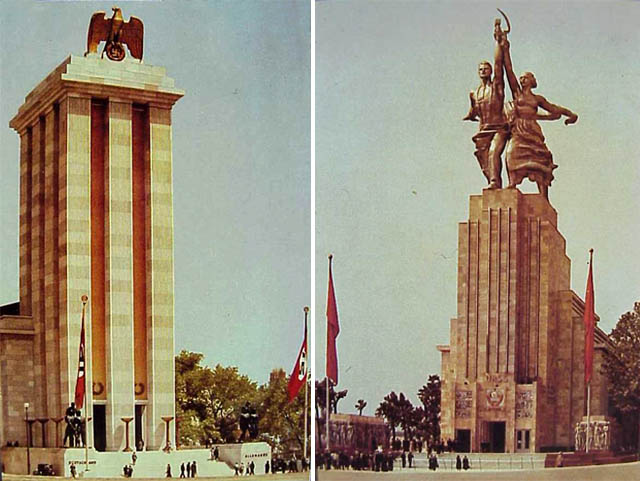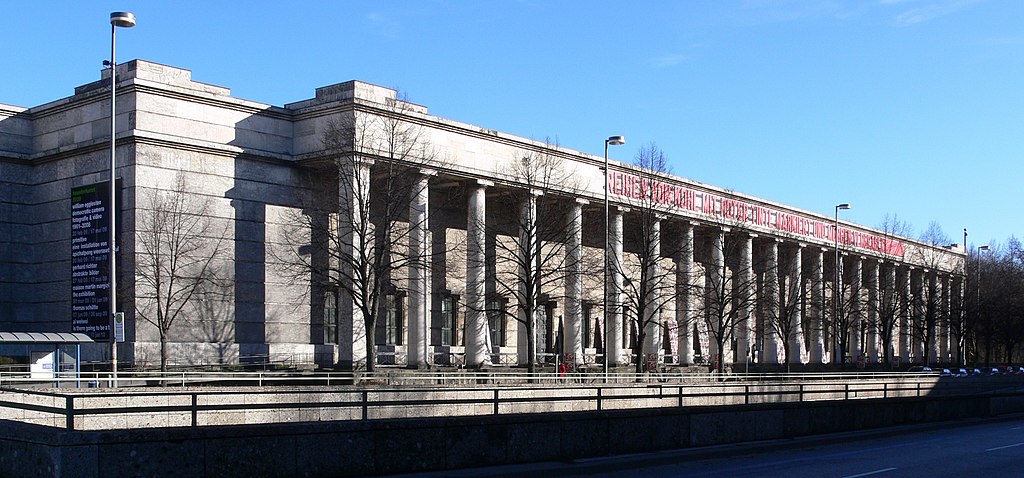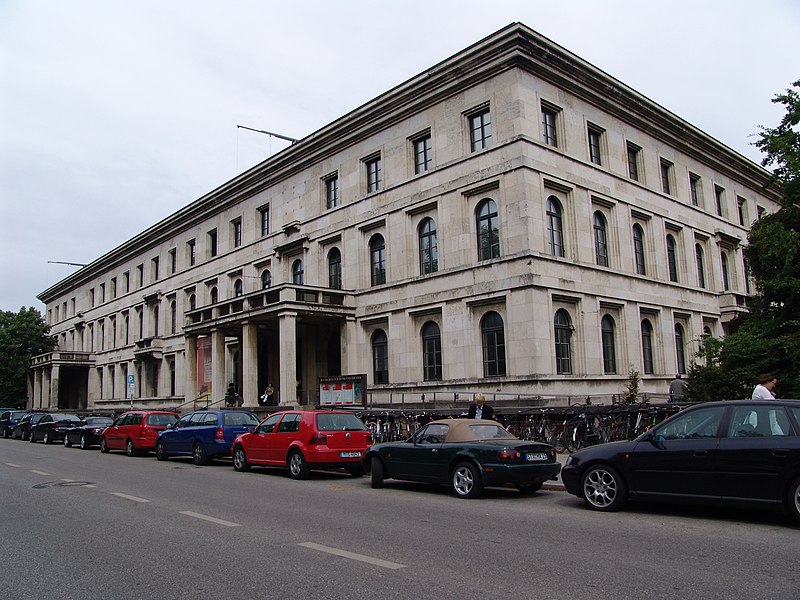Ναζιστική αρχιτεκτονική
το ναζιστικό περίπτερο, ακριβώ ς απέναντι από το σοβιετικό,
στη διεθνή έκθεση του Παρισιού 1937
Albert Speer
Exposition Internationale des Arts et Techniques dans la Vie Moderne
Mittelhalle
Haus der Kunst 1937
Paul Ludwig TroostTroost became a member of the modernist Deutscher Werkbund, and belonged to a school of architects like Peter Behrens and Walter Gropius who, even before 1914, reacted sharply against the highly ornamental Jugendstil movement and advocated a restrained, lean architectural approach, almost devoid of ornament.
the Haus der Kunst (House of German Art) in Munich,[4] modeled on Schinkel's Altes Museum in Berlin
The Führerbau
- translated as "the Führer's building" - was built from 1933 to 1937 after the plans of architect Paul Ludwig Troost, at the address Arcisstrasse 12 in Maxvorstadt, Munich. The first plans were made in 1931. The building was completed three years after Troost's death by Leonhard Gall.
εδώ υπογράφτηκε το 1938 από τους Χίτλερ & Τσάμπερλεν η συνθήκη του Μονάχου
Panorama des KdF-Hauses im Seebad Prora. Ansicht von der Landseite.
Prora 1936-9
Es gilt als das längste Gebäude der Welt.
Viereinhalb Kilometer Stahlbeton ragen hinter den Dünen am Strand auf Rügen hervor.
Auf der Insel Rügen legt die NS-Organisation Kraft durch Freude (KdF) am 2. Mai 1936 den Grundstein für die Ferienanlage in Prora, die aus acht aneinandergereihten baugleichen Häuserblocks besteht.
The enormous building complex is 4.5 kilometres (2.8 mi) in length
Prora 1936-9
Designed by Clemens Klotz
Rekonstruktion eines geplanten Zimmers der KdF-Zeit, das real nie zur Ausführung gelangte
Prora
Reichsparteitagsgelände
Zeppelinfeld
Albert Speer
It was intended to serve as a congress center for the NSDAP with a self-supporting roof and should have provided 50,000 seats. It was located on the shore of and in the pond Dutzendteich and marked the entrance of the rally grounds.
The building reached a height of 39 m (128 ft) (a height of 70 m was planned) and a diameter of 250 m (820 ft).
The building is mostly built out of clinker with a facade of granite panels.
The design (especially the outer facade, among other features) is inspired by the Colosseum in Rome.
Detlev-Rohwedder Haus
was the largest office space in the world when it was constructed in 1936. The building is most famous for housing the Ministry of Aviation of The Third Reich.
It was designed by Ernst Sagebiel, a prominent architect that was also responsible for the reconstruction design of the Tempelhof airport.
The Detlev Rohwedder Haus was described as “in the typical style of National Socialist intimidation architecture,” due to its gigantic size.
The New Reich Chancellery as pictured on Voss Street
Reichskanzlei
Albert Speer
The New Reich Chancellery's garden portal (gateway)
Reichskanzlei
Albert Speer

The New Reich Chancellery's Courtyard of Honor
Reichskanzlei
Albert Speer
NS Ordensburg is a common name for three remote castle-like schools that were supposed to educate the future party leaders.
The first one was built in 1934, Ordensburg Sonthofen in Allgau, following the design of Hermann Giesler.
Olympiastadion in 1936
Werner March
The most significant battle around the Olympiastadion was in April 1945 when the Soviet army fought to capture it. This was during the final battle of the Second World War in Europe, with the total invasion of Berlin as the Allies' target. The Olympiastadion survived the war almost untouched; it only suffered the impact of machine gun shots.
σχέδιο για πολεμικό μνημείο στο Kutno 1942
Wilhelm Kreis
Flakturm IV – Heiligengeistfeld, Hamburg
Das im Jahr 1940 fertiggestellte
neue Reichsbankgebäude
am Werderschen Markt in Berlin-Mitte
Heinrich Wolff
Federal Foreign Office Berlin
In close cooperation with the artist Gerhard Merz,
Hans Kollhoff
developed an art concept integrated into the conversion, lending the building renewed freshness and colour through the use of predominantly monochrome surfaces in important parts of the building.
σύγκρινέ το με το νέο υπουργείο εξωτερικών στο Βερολίνο του 2000
Hans Kollhoff
He is a representative of Postmodern and New Classical Architecture, as well as a protagonist of New Urbanism.
ανακατασκευή της Reichsbank του 1939
O σύγχρονός μας αρχιτέκτονας δήλωσε για το έργο του:
"Οποιοσδήποτε νομίζει ότι αυτό το κτήριο είναι ναζιστικό βρίσκεται σε λάθος δρόμο. Είναι ένα δείγμα του συντηρητικού, μοντέρνου στιλ αρχιτεκτονικής."












.jpg)





Σχόλια
Δημοσίευση σχολίου